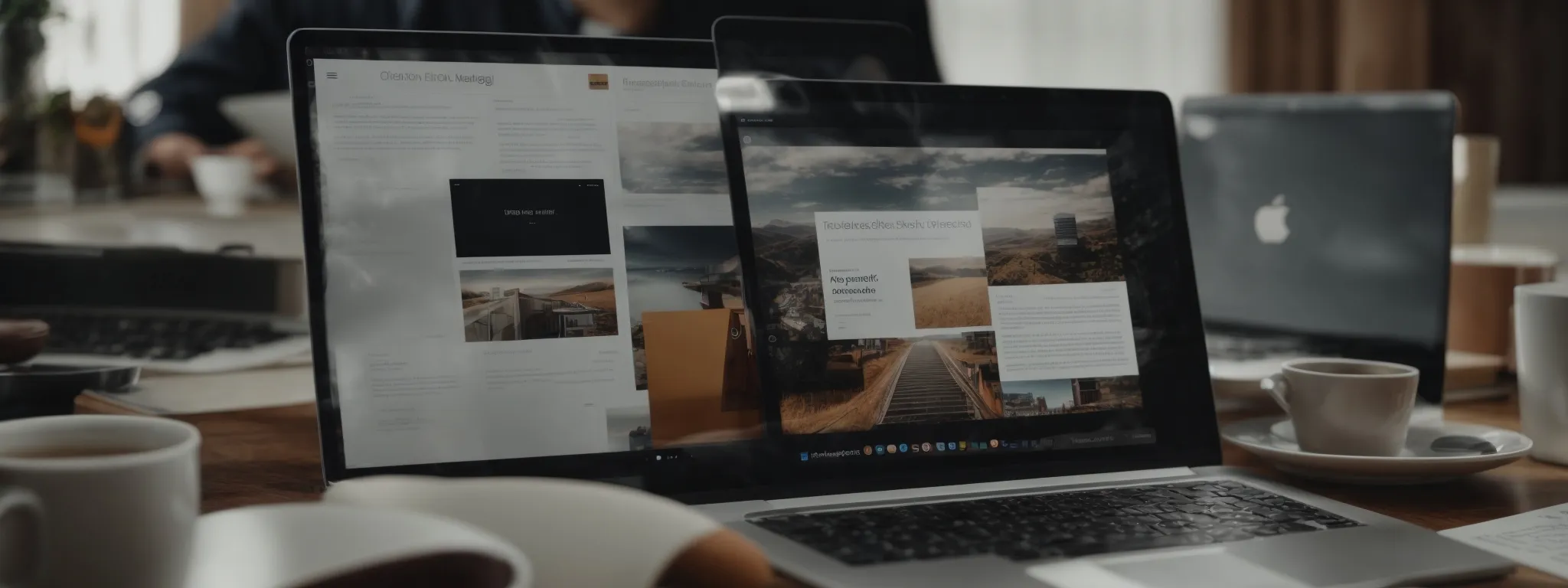Unlock Success with Optimized Landing Pages
Maximize Your Conversions: The Art of Crafting Optimized Landing Pages Crafting a landing page that turns visitors into customers is both a science and an art, one […]
Maximize Your Conversions: The Art of Crafting Optimized Landing Pages
Crafting a landing page that turns visitors into customers is both a science and an art, one that marries compelling content with strategic design.
In the quest to improve conversion rates, businesses must focus on creating a seamless user experience, where every element on the page directs a potential customer towards the primary conversion goal.
From the precision of wording on your calls-to-action to the psychological pull of social proof, enhancing the landing page experience is pivotal for converting a visitor into a client.
Optimizing for mobile users and employing rigorous testing can further sharpen your marketing efforts, leading to a significant uptick in engagement and sales.
Keep reading to unlock the secrets of a high-converting landing page that resonates with your target audience.
Key Takeaways
- A Clear Value Proposition Is Essential for High Landing Page Conversion Rates
- Effective Landing Page Design and Use of Whitespace Can Significantly Improve User Experience
- The Inclusion of Persuasive Visuals and Testimonials Enhances Credibility and Aids Conversions
- Mobile Optimization of Landing Pages Is Crucial for Engaging the on-the-Go Audience
- A/B Testing and the Use of Analytics Are Key to Refining Landing Pages for Better Conversions
Unveil the Elements of a High-Converting Landing Page

The digital landscape is fiercely competitive, obliging businesses to seize every opportunity to captivate and convert their target audience.
A landing page acts as a gateway, offering a tailored destination for visitors; it must be meticulously designed to guide them towards a singular conversion goal.
This endeavor calls for a keen understanding of various components that contribute to page effectiveness.
Recognizing the pivotal role of a well-defined value proposition, alongside other vital elements, sets the foundation for a landing page capable of achieving impressive conversion rates.
Navigating these waters, marketers and organizations must prioritize crafting a user experience that aligns with their audience’s expectations and needs, ensuring every landing page serves as a powerful instrument for customer engagement and conversion.
Identify the Core Components of a Successful Page
At the heart of a successful landing page lies a clear value proposition, a statement artfully conveying the unique benefit that the product or service offers to the user. This value proposition must resonate with the target audience, addressing specific pain points while distinguishing the company’s offerings from those of competitors.
Moreover, a meticulously optimized call-to-action (CTA) is a critical element of landing page architecture. It serves as the keystone guiding site visitors towards the desired action, whether that be signing up for a newsletter, making a purchase, or requesting more information. The CTA must be both visually striking and strategically placed, encouraging user engagement and facilitating the transition from visitor to customer.
Understand the Importance of Value Propositions
In digital marketing, an effective value proposition is the cornerstone of landing page optimization, directly influencing conversion rates. It succinctly answers the fundamental question of why a user should opt for a particular brand or product, establishing a direct connection with the visitor’s needs and expectations.
It is essential for the value proposition to be clearly communicated, offering immediate understanding of the benefits. This stellar clarity provides a compelling reason for the target audience to choose one company over another, thereby increasing the likelihood of visitor conversion to a customer.
- Begin with a strong headline that encapsulates the main benefit.
- Elucidate the advantages of the product or service with a subheading.
- Detail the key features and benefits that support the value proposition.
- Use persuasive visuals and testimonials to bolster credibility and trust.
- Ensure the value proposition aligns with the client’s needs and stands out amidst competition.
Simplify to Amplify: Streamline Landing Page Design

The design of a landing page is integral to its ability to convert.
Professionals in the realm of digital marketing understand that a well-structured, clean design not only captivates but also directs the user seamlessly towards the conversion goal.
A simplistic approach, characterized by smart use of whitespace and judiciously selected visuals, eliminates distractions and focuses the visitor’s attention where it matters most.
In today’s marketing landscape, where clarity and ease of navigation are paramount, these design strategies empower businesses to create more effective landing pages that resonate with their target audience and amplify conversion potential.
Embrace Whitespace for Better Readability
Whitespace, often referred to as negative space, is the unmarked segments of a landing page that contribute to its aesthetic and functional qualities. It provides visual breathing room for the reader, enhancing readability and user experience by drawing attention to the most significant elements on the page.
This strategic use of whitespace around text and titles aids in the viewer’s comprehension and retention of information, creating a serene and orderly visual landscape. A well-executed design using whitespace can channel the viewer’s focus to core messages and calls to action:
- Use ample margins and padding to create a clean layout.
- Segment the content with spacing to facilitate quick scanning.
- Contrast critical information with the surrounding space for emphasis.
Ultimately, embracing whitespace in landing page design is not merely an artistic choice but a calculated maneuver to guide the visitor’s journey toward conversion. The sophisticated deployment of this element underpins the clarity and effectiveness of the page, ensuring that calls to action resonate with the audience.
Choose Visuals That Enhance Your Message
Visual elements serve as silent ambassadors of the brand’s message, and choosing the right ones is central to the success of any landing page. They should complement and amplify the core message, allowing users to grasp the essence of the offer at a glance, thereby improving the landing page experience and encouraging deeper engagement.
Images, infographics, and videos must be harmonized with the overall landing page design and content, reinforcing the value proposition and CTA. This visual support should reinforce the message without competing for the reader’s attention, guiding them unobtrusively towards the ultimate goal of conversion:
| Element | Purpose | Impact on Conversion |
|---|---|---|
| Images | Visual appeal and emotional resonance | Higher engagement, reduced bounce rate |
| Infographics | Simplified presentation of information | Better understanding, more shares |
| Videos | Demonstration of product/service effectiveness | Increased time on page, higher trust |
Write Persuasive Copy That Drives Action

An online user’s journey begins with a click and culminates in action, a pathway delicately paved by the artistry of persuasive copy on a landing page.
It is the mastery of language that turns browsers into buyers and prospects into leads.
The allure of a powerful headline coupled with the credibility of clear, honest content has the potential to dramatically influence landing page conversion rates.
To engage a reader’s attention and fuel their decision-making process, it’s essential to wield the written word with precision and persuasive intent, ensuring that each phrase and paragraph propels the audience towards fulfilling the conversion goal.
Master the Art of Headline Creation
The essential first impression of any landing page is its headline, a crucial element that shapes the narrative and hooks the visitor’s interest. In mere seconds, it must capture the essence of the offer, propel clarity, and establish the tone for the user’s journey through the content, coaxing them into a conversion mindset.
Proficiency in crafting headlines involves a blend of creativity and strategic wording, emphasizing the benefits that directly resonate with the target audience. By prioritizing the primary value proposition, a headline can transform a mere glance into a genuine interest, setting the stage for a persuasive user experience:
- Distill the central message into a concise, compelling headline.
- Integrate keywords naturally to assist with both clarity and search relevance.
- Foster a sense of urgency or curiosity to encourage immediate engagement.
Build Trust With Transparent and Concise Content
In the realm of digital marketing, transparency is not just a buzzword; it’s the bedrock of trust between a company and its site visitors. Clear and concise content on a landing page reassures the reader, affirming the authenticity of the brand and the veracity of its offerings.
Conciseness in content delivery is indispensable, ensuring that each word serves a purpose: to inform, reassure, and guide the visitor towards a risk-free decision. The promise of value, devoid of obscurity or ambiguity, fosters a sense of reliability and encourages the establishment of a trusting relationship:
- Highlight features and benefits in an honest, straightforward manner.
- Avoid jargon and complex language that might obscure the message.
- Provide accessible content that reaffirms the brand’s commitment to transparency.

The digital avenue to successful conversions is a seamless and intuitive user experience – a principle that is quintessential when designing optimized landing pages.
As users traverse the finely-crafted path laid out before them, it is the strategic implementation of a logical flow and the minimization of friction points that retains their engagement, steering visitors unerringly toward the intended action.
Reflecting on the artistry of conversion optimization will reveal methods for streamlining user interaction that make the difference between a landing page that simply informs and one that effectively converts.
Implement a Logical Flow That Guides Visitors
An intuitive navigation structure on a landing page is tantamount to carving out a clear pathway for visitors, ensuring they encounter no obstacles on their journey towards the conversion goal. The smoother the navigation, the more likely a business is to lead prospective clients through the funnel, from initial curiosity to a final, decisive action.
Experts recognize that strategic placement and visibility of navigation elements empower visitors to move through content with ease, Fostering a Sense of Control and willingness to engage. As they seamlessly interact with the page, confidence in the product and the organization behind it grows, organically nurturing conversions.
Reduce Friction Points That Deter Engagement
To maximize the impact of a landing page, it is essential to identify and Eliminate Friction Points that may deter engagement. Friction points are elements or aspects of a user interface that interrupt the flow of user interaction, potentially causing confusion and reducing the likelihood of conversion.
Streamlining web page design and simplifying forms are pivotal strategies for reducing these hindrances. Complicated navigation or a cumbersome checkout process can impede user progress and diminish the effectiveness of the landing page:
- Ensure smooth and logical progression from one section to the next.
- Optimize form fields to request only essential information.
- Invest in page load speed enhancements to prevent user drop-off due to impatience.
Each of these strategies is implemented with a clear aim: to construct a landing page experience that is as effortless as possible for the visitor. By prioritizing easy navigation and reducing barriers to user action, a business can significantly boost its landing page conversion rate and, as a result, its marketing campaign success.
Create Compelling Calls-to-Action That Convert

In the pursuit of digital marketing excellence, the creation of an effective call-to-action (CTA) is not merely a nicety but a necessity, pivotal in the journey from prospective interest to actual conversion.
The final, decisive step on a landing page is the catalyst that prompts action; hence, crafting a CTA with precision is of paramount importance.
This critical component must encompass language that incites action, designs that capture the eye, and placements that intuitively align with the user’s navigation.
Exploring the multifaceted aspects of CTAs, from the psychology of action-oriented language to the empirical results of meticulous testing, businesses can significantly refine their approach, enhance user engagement, and achieve higher conversion rates.
Use Action-Oriented Language for Immediate Impact
The effectiveness of a call-to-action hinges on its ability to prompt an immediate response. Utilizing verbs that convey urgency and relevance ensures that the message is not only seen but felt, compelling the recipient to take the next step swiftly and decisively.
Mastery in the use of action-oriented language transforms passive observers into active participants. With each directive phrase—such as “Register Now,” “Get Started Today,” or “Claim Your Free Trial”—the user is guided closer to the pinnacle of the conversion process: taking meaningful action.
| Action-Oriented Phrase | Purpose | Desired Outcome |
|---|---|---|
| Register Now | To create a sense of immediacy and ease | User signs up and enters the conversion funnel |
| Get Started Today | To highlight the accessibility of beginning | User initiates engagement with the product or service |
| Claim Your Free Trial | To offer a no-risk opportunity to experience the offering | User tries the product or service, potentially leading to purchase |
Test Different CTA Button Designs and Placements
To harness the full potential of a Call-to-Action (CTA), Meticulous Evaluation and Variation of its design and placement are indispensable. Digital marketers must acknowledge the influence of these elements on user behavior and, by implementing A/B testing, they can determine which configurations resonate most effectively with their audience, leading to higher conversion rates.
The visual appeal of the CTA button—encompassing the color, shape, and font—and its strategic positioning on the landing page wield significant power over a visitor’s decision-making process. Successful marketers not only craft CTA buttons that stand out but also judiciously place them in intuitive locations that align with the natural flow of reading, thereby maximizing the possibility of user engagement and conversion.
Ensure Seamless Mobile Experiences

In the digital era, where smartphones are an extension of the individual, it is crucial for digital marketing strategies to embrace mobile-first methodologies.
A landing page that excels on desktop is only half the battle; optimizing for mobile experiences is equally vital to capture the growing audience that prefers browsing on smaller screens.
Engaging this segment requires a nuanced approach to design and functionality where touch interactions are intuitive and load times are lightning-fast, ensuring the user’s journey towards conversion is unhindered regardless of their device.
Optimize Layout for Touch Interactions
In the current digital climate, the optimization of landing pages for touch interactions stands as a critical component of mobile user engagement. Designers of digital content must account for the tactile nature of mobile devices, ensuring buttons are of adequate size for fingertips and that interactive elements are accessible within the thumb’s natural range of motion.
Ensuring that a mobile landing page accommodates the gestural intricacies of touch, such as swiping, tapping, and pinching, directly influences the quality of the user experience. This meticulous attention to detail underpins the effectiveness of mobile landing pages, fostering an environment conducive to increased user interaction and conversion.
Accelerate Load Times for on-the-Go Users
For the constantly moving audience, every second that a landing page takes to load can mark the difference between engagement and abandonment. A swift load time is not just an expectation but a necessity for mobile users, as high-speed delivery of content keeps pace with the urgency of on-the-go browsing.
Optimizing a landing page for rapid loading on mobile devices is a commitment to the user’s time and a reflection of an organization’s understanding of mobile user behavior. The prioritization of speed enhances user satisfaction, invariably leading to improved retention and a higher propensity for conversion.
| Mobile Optimization Focus | User Impact | Conversion Influence |
|---|---|---|
| Rapid Load Times | Immediate access to content | Increased engagement and lower bounce rates |
| Touch-Friendly Navigation | Intuitive interaction with page elements | Seamless journey enhancing likelihood of conversion |
| Responsive Design | Uniform experience across devices | Consistent messaging that supports brand credibility |
Boost Conversions With a/B and Multivariate Testing

In an ever-evolving digital marketplace, the optimization of landing pages is an exercise in precision and adaptability.
A/B and multivariate testing emerge as instrumental techniques enabling marketers to distill data-driven insights into tangible improvements in conversion rates.
Through meticulous testing and evaluation, businesses can isolate variables, uncovering the most effective elements that drive user action.
This systematic approach not only bolsters current marketing efforts but also equips digital professionals with valuable knowledge to inform and refine future strategies with greater confidence and clarity.
Formulate Hypotheses for Conversion Rate Improvement
The pursuit of heightened conversion rates begins with the careful construction of hypotheses, informed by an understanding of user behavior and a deep dive into analytics. These conjectures posit the potential impact of changes to design, content, or functionality on the effectiveness of landing pages, setting the stage for empirical evaluation through A/B and multivariate testing.
Success in the digital marketing arena relies on the ability to make informed decisions grounded in data. By examining trends and identifying patterns of interaction, marketers craft targeted hypotheses that anticipate the reaction of their audience to subtle alterations, paving the way for incremental enhancements that collectively serve to optimize conversion performance.
Evaluate Results to Inform Future Optimizations
Post-testing analysis is the cornerstone of landing page optimization, with the gathered data serving as a beacon to guide subsequent marketing choices. By evaluating the outcomes of A/B and multivariate tests, marketers can make precise adjustments, enhancing the effectiveness of each element on the landing page to refine user experience and maximize conversions.
With each cycle of testing and evaluation, digital marketing professionals cultivate a richer understanding of their audience’s preferences and behaviors. This iterative process allows for the fine-tuning of landing pages, ensuring that future optimizations are always informed by empirical evidence and directed towards sustaining and elevating conversion rates.
Leverage Social Proof to Establish Credibility

In the realm of conversion rate optimization, the power of social proof cannot be overstated.
A landing page that harnesses social validation through customer endorsements and influential testimonials transcends mere self-promotion—it embodies trust, reliability, and user satisfaction.
When potential customers witness the positive experiences of others, credibility is fostered, forming a crucial bridge between interest and action.
As we delve into the nuances of leveraging social proof, it becomes evident that testimonials and the stamp of approval from respected figures not only elevate a brand but also significantly bolster conversion efforts.
Showcase Customer Testimonials and Reviews
Incorporating customer testimonials and reviews into the fabric of landing pages casts a resounding echo of trust and authenticity. Real-world experiences and accolades from genuine clients act as a beacon, drawing new visitors toward the conversion threshold with the assurance that the path they tread has been well-worn and rewarding.
Strategically placed testimonials can transcend simple endorsements, serving as relatable narratives that articulate the user’s triumphs with the product or service. They provide a platform for prospective customers to visualize the potential outcomes of their engagement, effectively propelling them from contemplation to decisive action.
Feature Endorsements From Respected Figures
Endorsements from industry experts and renowned figures carry substantial weight in the digital domain, fundamentally strengthening a landing page’s ability to convert. The prestige and recognition associated with respected authorities imbue a product or service with an elevated sense of trustworthiness, persuading users to take affirmative actions backed by expert validation.
By showcasing accolades or approbations from influential personalities, companies effectively bridge the gap between skepticism and trust. This strategic use of authority endorsements on landing pages amplifies credibility, enabling organizations to captivate and convert an audience relying on the commendations of revered figures.
Utilize Analytics for Data-Driven Decisions

A pivotal element in the tapestry of landing page success is the astute application of analytics, providing the insights necessary to refine the user’s journey towards the ultimate conversion.
By harnessing the power of data, organizations can uncover patterns and preferences in user behavior, effectively tailoring their strategies to resonate with their audience.
As professionals delve into the intricacies of performance metrics, they gain the prowess to adjust and enhance their landing pages, ensuring each tweak is informed by concrete evidence and aligned with the objective of maximizing conversions.
Track User Behavior to Uncover Insights
In the realm of digital marketing, the systematic tracking of user behavior stands as a crucial element for landing page refinement. This granular observation equips marketers with the necessary insights to understand how visitors interact with each segment of the page, pinpointing elements that captivate attention and those that may cause friction or disengagement.
Analytics tools, such as those offered by LinkGraph’s SearchAtlas platform, provide comprehensive data on user flows, engagement metrics, and conversion paths. By leveraging these sophisticated resources, organizations can identify behavioral trends and optimize their landing pages, ensuring they harmonize with the preferences and patterns of their target audience to drive conversion success.
Adjust Strategies Based on Performance Metrics
The adept use of performance metrics acts as a compass for digital marketers, guiding the refinement of strategies to optimize landing pages for peak conversion rates. With tools like LinkGraph’s SearchAtlas SEO software, marketers gain access to real-time analytics that unveil which elements of the landing page resonate with users and which aspects need adjustment to better align with conversion objectives.
Performance metrics shine a light on the effectiveness of content, CTA placement, and design elements, allowing iteration with precision. This continuous process of analysis and adaptation is indispensable, enabling an organization to dynamically refine its landing page in response to user engagement trends and evolve its digital marketing solutions to stay ahead of the curve.
Foster Engagement With Interactive Landing Page Features

In the dynamic sphere of digital marketing, an interactive landing page stands as a beacon of innovation, skillfully merging user engagement with conversion potential.
By weaving interactive features such as quizzes and calculators into the fabric of a landing page, businesses can foster deeper interaction, personalizing user experience and fortifying the connection between the company and its audience.
Additionally, implementing mechanisms for social sharing catapults the reach of a landing page well beyond its initial audience, harnessing the power of networks to amplify brand presence and conversion opportunities.
Include Quizzes or Calculators to Increase Interaction
In the pursuit of digital marketing solutions that drive user engagement, the inclusion of interactive features such as quizzes and calculators on landing pages is an ingenious approach: It not only captivates visitors but also provides them with personalized insights, increasing the time they spend on the page.
| Interactive Feature | Function | Impact on User Engagement |
|---|---|---|
| Quizzes | Personalized assessments that provide valuable feedback | Lengthens session duration and deepens user interest |
| Calculators | Tools that offer immediate, custom calculations for the user | Enhances user experience by adding practical value to the visit |
Consideration for the user’s journey is paramount when deploying these elements; they should seamlessly integrate with the visual and textual narrative of the landing page, energizing the call to action with data-driven, interactive touchpoints that lead towards conversion.
Encourage Social Sharing to Expand Your Reach
In the realm of digital marketing solutions, the encouragement of social sharing stands as an influential factor in elevating the visibility and conversion potential of a landing page. By integrating social share buttons in prominent positions on the page, organizations empower visitors to effortlessly disseminate the content within their networks, thereby amplifying the digital footprint and Converting Users Into Brand Ambassadors.
Strategic placement of social sharing capabilities transforms each visitor into a potential vector for organic reach expansion. When a business crafts its landing pages to not only inform and convert but also to facilitate sharing, it sets the stage for amplified exposure, tapping into the vast, interconnected web of social media users primed for discovery and engagement.
Conclusion
In conclusion, the art of crafting optimized landing pages is essential for maximizing conversions in the digital marketing space.
A successful landing page stems from a clear value proposition and a compelling call-to-action, both of which should resonate with the target audience to drive engagement.
Simplifying design through whitespace and choosing visuals that enhance the message are key to holding the user’s attention.
Persuasive copy and intuitive navigation further smooth the path towards conversion, while ensuring mobile optimization provides a seamless experience for on-the-go users.
Implementing A/B and multivariate testing allows for data-driven refinements that sharpen the page’s effectiveness.
Social proof, such as customer testimonials and endorsements, bolsters credibility and can significantly impact conversion rates.
Performance metrics from analytics tools are instrumental in adjusting strategies and fostering continuous improvement.
Lastly, incorporating interactive features enriches the user experience and encourages social sharing, broadening the page’s reach.
The cumulative effect of these elements, when executed with skill, amplifies conversions, signifying the profound importance of well-crafted landing pages in achieving online marketing success.














































































